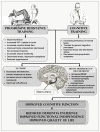Study of Mental Activity and Regular Training (SMART) in at risk individuals: a randomised double blind, sham controlled, longitudinal trial
- PMID: 21510896
- PMCID: PMC3110111
- DOI: 10.1186/1471-2318-11-19
Study of Mental Activity and Regular Training (SMART) in at risk individuals: a randomised double blind, sham controlled, longitudinal trial
Abstract
Background: The extent to which mental and physical exercise may slow cognitive decline in adults with early signs of cognitive impairment is unknown. This article provides the rationale and methodology of the first trial to investigate the isolated and combined effects of cognitive training (CT) and progressive resistance training (PRT) on general cognitive function and functional independence in older adults with early cognitive impairment: Study of Mental and Regular Training (SMART). Our secondary aim is to quantify the differential adaptations to these interventions in terms of brain morphology and function, cardiovascular and metabolic function, exercise capacity, psychological state and body composition, to identify the potential mechanisms of benefit and broader health status effects.
Methods: SMART is a double-blind randomized, double sham-controlled trial. One hundred and thirty-two community-dwelling volunteers will be recruited. Primary inclusion criteria are: at risk for cognitive decline as defined by neuropsychology assessment, low physical activity levels, stable disease, and age over 55 years. The two active interventions are computerized CT and whole body, high intensity PRT. The two sham interventions are educational videos and seated calisthenics. Participants are randomized into 1 of 4 supervised training groups (2 d/wk×6 mo) in a fully factorial design. Primary outcomes measured at baseline, 6, and 18 months are the Alzheimer's Disease Assessment Scale (ADAS-Cog), neuropsychological test scores, and Bayer Informant Instrumental Activities of Daily Living (B-IADLs). Secondary outcomes are psychological well-being, quality of life, cardiovascular and musculoskeletal function, body composition, insulin resistance, systemic inflammation and anabolic/neurotrophic hormones, and brain morphology and function via Magnetic Resonance Imaging (MRI) and Spectroscopy (fMRS).
Discussion: SMART will provide a novel evaluation of the immediate and long term benefits of CT, PRT, and combined CT and PRT on global cognitive function and brain morphology, as well as potential underlying mechanisms of adaptation in older adults at risk of further cognitive decline.
Trial registration: Australia and New Zealand Clinical Trials Register (ANZCTR): ANZCTRN12608000489392.
Figures



References
-
- Andrieu S, Coley N, Aisen P, Carrillo MC, Dekosky S, Durga J, Fillit H, Frisoni GB, Froelich L, Gauthier S, Jones R, Jönsson L, Khachaturian Z, Morris JC, Orgogozo JM, Ousset PJ, Robert P, Salmon E, Sampaio C, Verhey F, Wilcock G, Vellas B. Methodological issues in primary prevention trials for neurodegenerative dementia. Journal of Alzheimer's Disease. 2009;16(2):235–270. - PubMed
-
- Katzman R. Education and the prevalence of dementia and Alzheimer's disease. Neurology. 1993;43:13–20. - PubMed
-
- Valenzuela MJ, Sachdev P. Brain reserve and dementia: A systematic review. Psychological Medicine. 2006;36(4):441–454. - PubMed
Publication types
MeSH terms
LinkOut - more resources
Full Text Sources
Medical

